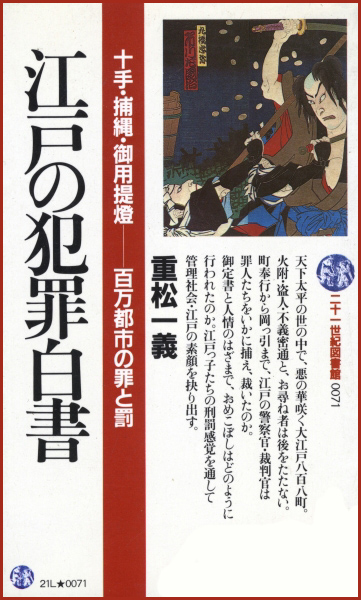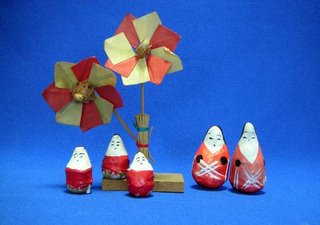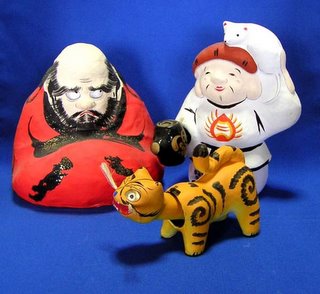https://edoflourishing.blogspot.jp/2017/02/hanzai-crime-glossary.html
[ . BACK to DARUMA MUSEUM TOP . ]
. Edo bakufu 江戸幕府 The Edo Government .
::::::::::::::::::::::::::::::::::::::::::::::::::::::::::::::::::::::::::::::::::::::::::::::::::::::::::::::::::::::::::::::::::::::::::::::::::::::::::::::::::::::::::::::::::::
hanzai 犯罪 crime and punishment - Glossary

江戸の犯罪白書 十手・捕縄・御用提燈-百万都市の罪と罰
重松一義
:::::::::::::::::::::::::::::::::::::::::::::::::::::::::::::::::::::::::::::::::::::::::::::::::::::::::::::::::::::::::::::::::::::::::::::::::::::::::::::::::::::::::::::::::::::
- - - - - Alphabetical Index of Keywords - - - - -
- AAA - / - BBB - / - CCC - / - DDD - / - EEE -
- FFF - / - GGG - / - HHH - / - I I I - / - JJJ -
- KK KK - / - LLL - / - MMM - / - NNN - / - OOO -
- PPP - / - QQQ - / - RRR - / - SSS - / - TTT -
- UUU - / - VVV - / - WWW - / - XXX - / - YYY - / - ZZZ -
:::::::::::::::::::::::::::::::::::::::::::::::::::::::::::::::::::::::::::::::::::::::::::::::::::::::::::::::::::::::::::::::::::::::::::::::::::::::::::::::::::::::::::::::::::::

. Hasegawa Heizoo, Hasegawa Heizô 長谷川平蔵 Hasegawwa Heizo .
Onihei Hankachō 鬼平犯科帳 Onihei Hankacho
::::::::::::::::::::::::::::::::::::::::::::::::::::::::::::::::::::::::::::::::::::::::::::::::::::::::::::::::::::::::::::::::::::::::::::::::::::::::::::::::::::::::::::::::::::
bakufu 幕府 the Edo government
banya 番屋 prison
bugyoo, bugyō 奉行 Bugyo officials, Commissioners in the Edo government - full list
Buke shohatto 武家諸法度 Laws for the Samurai
(lit. Various Points of Laws for Warrior Houses)
dooshin 同心 Doshin, lesser police officer
gokei 五刑 five judicial penalties
goyoo choochin 御用提燈 Goyo Chochin, police lanterns
Hasegawa Heizô 長谷川平蔵 Hasegawwa Heizo / 鬼平 Onihei (1745 - 1795)
hitsuke toozoku aratemekata 火付け盗賊改 special police for arson and robberies
jishinban 自身番 / kidoban 木戸番 Guardian of a neighbourhood "gate"
- - - nowadays koban 交番 police box in the neighbourhood
jitte, jittei, jutte 十手 / 實手 metal truncheon, "ten hands"
keibatsu 刑罰 punishment
keisatsu 警察 police (after the Meiji restauration)
Kodenma-choo, Kodenma-chō 小伝馬町 Kodenma-cho prison in Edo
machibugyoo 町奉行 Machibugyo, town commissioner, magistrate and metropolitan governor and district court chief justice
(Minami Machibugyo and Kita Machibugyo)
meakashi 目明し semi-official detective
metsuke 目付 inspector
mushuku 無宿 vagabong, homeless
ninsoku yoseba 人足寄場 rehabilitation facility for criminals
- installed as a means to prevent crime
okappiki 岡引 semi-official detective
Onihei 鬼平 / Hasegawa Heizô 長谷川平蔵 Hasegawwa Heizo
oobanya 大番屋 Obanya, main prison
Ooka Echizen 大岡越前守, Ooka Tadasuke (1677 - 1752)
oometsuke 大目付 Ometsuke, chef of the inspectors, inspector general
rooju, rôjû 老中 "chief elder" - senior counselor
rōya, rooya 牢屋 Roya, the Shogunal prison
seppuku 切腹 death penalty for a samurai, honorable suicide
shirasu 白州 "white pebbles" court room outside the magistrate's office
shisai 死罪 death penalty (of a commoner)
shokei 処刑 execution
Tanuma Okitsugu 田沼意次 (1719 - 1788)
teshita 手下 undercover informants of the Doshin
Tooyama 遠山景元 Toyama Saemon no Jo Kagemoto - (1793 – 1855) Tōyama no Kin-san 遠山の金さん
torimono 捕物 police arrest
torimonochoo 捕物帳 document about an arrest
torinawa (hojoo) 捕縄 policeman's rope, "capture-rope" - arresting cord
yakuza やくざ / ヤクザ gangster, gang of gangsters
yoriki 与力 police inspectors
zenka 前科 criminal record
zanzai 斬罪 beheading (of a samurai)
- - - - -
- to be updated regularly -

十手・捕縄事典 - 江戸町奉行所の装備と逮捕術
名和弓雄 Nawa Yumio (1912 - 2006)
. Nawa Yumio - Contents of the book .
:::::::::::::::::::::::::::::::::::::::::::::::::::::::::::::::::::::::::::::::::::::::::::::::::::::::::::::::::::::::::::::::::::::::::::::::::::::::::::::::::::::::::::::::::::::
. Criminal Punishment in Edo .
a glossary of terms

Kozukappara keijoo 小塚原刑場 Kozukappara execution grounds
Suzugamori keijoo 鈴ヶ森刑場 Suzugamori execution grounds
. Kubizuka 首塚 memorial stone pagodas and mounds for the beheaded .
::::::::::::::::::::::::::::::::::::::::::::::::::::::::::::::::::::::::::::::::::::::::::::::::::::::::::::::::::::::::::::::::::::::::::::::::::::::::::::::::::::::::::::::::::::
- quote -
Edo period police
In feudal Japan, individual military and citizens groups were primarily responsible for self-defense until the unification of Japan by Tokugawa Ieyasu in 1603. During the Edo period (1603–1868), the Tokugawa shogunate formed a centralized feudal government.[1] Samurai warriors who once protected Japan from foreign enemies and fought each other for supremacy became the new police and internal security force.[2] Their new job would be to ensure civil peace, which they accomplished for over 250 years.
----- History
During the Edo period the authoritarian Tokugawa shogunate instituted an elaborate police/security state, an administrative hierarchy was developed, and rules and regulations controlling many aspects of life in Japan went into effect. This new system of government has been called a police state,[4] possibly the world's first.
In 1868
the samurai era ended with the overthrow of the Tokugawa shogunate and a new government came into power (Meiji government) and the samurai class was eventually abolished. In 1872, a former samurai [Kawaji Toshiyoshi] was sent to Europe to study systems of policing and he recommended a restructuring based partially on French and Prussian systems. In 1874, a nationalized police force was created using European police systems as a model. This new police force was the start of the modern police system in Japan, though it was initially dominated by former samurai from Satsuma who were part of the driving force behind the removal of the Tokugawa shogunate. The new Meiji period police continued the Edo period method of Japanese police controlling societal behavior and internal security as well as preventing and solving crimes.
----- Organization
The Edo period police apperatus utilized a multi-layered bureaucracy which employed the services of a wide variety of Japanese citizens. High and low ranking samurai, former criminals, private citizens and even citizens groups (Gonin Gumi) participated in keeping the peace and enforcing the laws and regulations of the Tokugawa shogunate.
----- Samurai police
Machi-bugyō
During the Edo period, high ranking samurai with an allegiance to the Tokugawa shogunate (hatamoto) were appointed machi-bugyō (city administrators or commissioners). The machi-bugyō performed the roles of chief of police, prosecutor, judge and other judicial related business both criminal and civil in Edo and other major towns.
Yoriki
Working under the machi-bugyō was the yoriki. Yoriki were samurai—they managed patrols and guard units composed of lower ranking police officials. Yoriki, being of a higher class, were able to ride a horse while performing their duties and were trusted to carry out assignments of high importance.
Dōshin
Working under the yoriki was the dōshin. Dōshin were samurai but of a lower class than yoriki—they performed the duties of prison guard and patrol officer which required close contact with commoners (chonin). They investigated crimes such as murder and helped with executions.
Non-samurai police assistants
Edo period police
relied heavily on commoners for assistance, from average village dwellers to the outcast hinin and eda castes. Members of the Japanese outcast were particularly helpful with guarding and executing prisoners, and disposing the bodies, something that samurai found to be repugnant (distasteful).
Komono
Komono were non-samurai chōnin who went with the dōshin on patrols and provided assistance.
Okappiki
Okappiki were non-samurai from the lowest outcast class, often former criminals who worked for the dōshin as informers and spies.
Gōyokiki/meakashi
Gōyokiki or meakashi were a non-samurai chōnin or outcast class who were hired by local residents and merchants to work as police assistants in a particular neighborhood—they were often former criminals. The term "tesaki" was used to describe gōyokiki or meakashi later in the Edo period.
----- Duties
Investigating crimes, arresting and interrogating arrested suspects, torturing criminal suspects in order to obtain a confession, punishing convicted criminals including executions.
----- Equipment
Edo period police used a variety of armor and carried lethal and non-lethal weapons to capture criminal suspects. If possible, suspected criminals were taken alive. This meant that special weapons and tactics had to be created in order to accomplish this task.
- - - Weapons
Bansho rokugin or keigo roku-go:
Edo period police stations were required to keep six kinds of weapons (bansho rokugin or keigo roku-go) available for use in case of disturbances.[16] these were the kanamuchi, the kiriko no bo, the tetto, the sodegarami, the tsukubo, and the sasumata.[Three of these tools were called torimono sandōgu ("three tools of arresting"), which consisted of the sodegarami, sasumata, and tsukubō. They were symbols of office and were often displayed in front of police checkpoints or used in processions, especially while convicted prisoners were being led to their execution.
Sodegarami
Sasumata
Tsukubo
Kanamuchi
Kiriko no bo
Tetto
Metsubushi
Jitte, Jutte: an iron or wooden club or truncheon, the jutte was a non-lethal weapon and an official symbol of office.
Te yari (hand spear): a small version of the yari suitable for use in confined spaces.
Kusari fundo/manriki
----- Armour
Edo period police and assistants wore chain armour clothing, armour for the hands, and armour for the head.
Hachi-gane (forehead protector).
Kusari katabira and kusari zukin (chain armor jacket and hood).
Han kote (gauntlets).
- - - More in the WIKIPEDIA !
::::::::::::::::::::::::::::::::::::::::::::::::::::::::::::::::::::::::::::::::::::::::::::::::::::::::::::::::::::::::::::::::::::::::::::::::::::::::::::::::::::::::::::::::::::

- - - To join me on facebook, click the image !
:::::::::::::::::::::::::::::::::::::::::::::::::::::::::::::::::::::::::::::::::::::::::::::::::::::::::::::::::::::::::::::::::::::::::::::::::::::::::::::::::::::::::::::::::::::
. Edo bakufu 江戸幕府 The Edo Government .
. Famous Places and Powerspots of Edo 江戸の名所 .
. Doing Business in Edo - 商売 - Introduction .
. shokunin 職人 craftsman, craftsmen, artisan, Handwerker .
. senryu, senryū 川柳 Senryu poems in Edo .
. Japanese Architecture - Interior Design - The Japanese Home .
. Legends and Tales from Japan 伝説 - Introduction .
[ . BACK to DARUMA MUSEUM TOP . ]
[ . BACK to WORLDKIGO . TOP . ]
- - - - - #hanzai #edocrime #edopolice #torimono - - - -
::::::::::::::::::::::::::::::::::::::::::::::::::::::::::::::::::::::::::::::::::::::::::::::::::::::::::::::::::::::::::::::::::::::::::::::::::::::::::::::::::::::::::::::::::
hanzai crime glossary
. Edo bakufu 江戸幕府 The Edo Government .
::::::::::::::::::::::::::::::::::::::::::::::::::::::::::::::::::::::::::::::::::::::::::::::::::::::::::::::::::::::::::::::::::::::::::::::::::::::::::::::::::::::::::::::::::::
hanzai 犯罪 crime and punishment - Glossary

江戸の犯罪白書 十手・捕縄・御用提燈-百万都市の罪と罰
重松一義
:::::::::::::::::::::::::::::::::::::::::::::::::::::::::::::::::::::::::::::::::::::::::::::::::::::::::::::::::::::::::::::::::::::::::::::::::::::::::::::::::::::::::::::::::::::
- - - - - Alphabetical Index of Keywords - - - - -
- AAA - / - BBB - / - CCC - / - DDD - / - EEE -
- FFF - / - GGG - / - HHH - / - I I I - / - JJJ -
- KK KK - / - LLL - / - MMM - / - NNN - / - OOO -
- PPP - / - QQQ - / - RRR - / - SSS - / - TTT -
- UUU - / - VVV - / - WWW - / - XXX - / - YYY - / - ZZZ -
:::::::::::::::::::::::::::::::::::::::::::::::::::::::::::::::::::::::::::::::::::::::::::::::::::::::::::::::::::::::::::::::::::::::::::::::::::::::::::::::::::::::::::::::::::::

. Hasegawa Heizoo, Hasegawa Heizô 長谷川平蔵 Hasegawwa Heizo .
Onihei Hankachō 鬼平犯科帳 Onihei Hankacho
::::::::::::::::::::::::::::::::::::::::::::::::::::::::::::::::::::::::::::::::::::::::::::::::::::::::::::::::::::::::::::::::::::::::::::::::::::::::::::::::::::::::::::::::::::
bakufu 幕府 the Edo government
banya 番屋 prison
bugyoo, bugyō 奉行 Bugyo officials, Commissioners in the Edo government - full list
Buke shohatto 武家諸法度 Laws for the Samurai
(lit. Various Points of Laws for Warrior Houses)
dooshin 同心 Doshin, lesser police officer
gokei 五刑 five judicial penalties
goyoo choochin 御用提燈 Goyo Chochin, police lanterns
Hasegawa Heizô 長谷川平蔵 Hasegawwa Heizo / 鬼平 Onihei (1745 - 1795)
hitsuke toozoku aratemekata 火付け盗賊改 special police for arson and robberies
jishinban 自身番 / kidoban 木戸番 Guardian of a neighbourhood "gate"
- - - nowadays koban 交番 police box in the neighbourhood
jitte, jittei, jutte 十手 / 實手 metal truncheon, "ten hands"
keibatsu 刑罰 punishment
keisatsu 警察 police (after the Meiji restauration)
Kodenma-choo, Kodenma-chō 小伝馬町 Kodenma-cho prison in Edo
machibugyoo 町奉行 Machibugyo, town commissioner, magistrate and metropolitan governor and district court chief justice
(Minami Machibugyo and Kita Machibugyo)
meakashi 目明し semi-official detective
metsuke 目付 inspector
mushuku 無宿 vagabong, homeless
ninsoku yoseba 人足寄場 rehabilitation facility for criminals
- installed as a means to prevent crime
okappiki 岡引 semi-official detective
Onihei 鬼平 / Hasegawa Heizô 長谷川平蔵 Hasegawwa Heizo
oobanya 大番屋 Obanya, main prison
Ooka Echizen 大岡越前守, Ooka Tadasuke (1677 - 1752)
oometsuke 大目付 Ometsuke, chef of the inspectors, inspector general
rooju, rôjû 老中 "chief elder" - senior counselor
rōya, rooya 牢屋 Roya, the Shogunal prison
seppuku 切腹 death penalty for a samurai, honorable suicide
shirasu 白州 "white pebbles" court room outside the magistrate's office
shisai 死罪 death penalty (of a commoner)
shokei 処刑 execution
Tanuma Okitsugu 田沼意次 (1719 - 1788)
teshita 手下 undercover informants of the Doshin
Tooyama 遠山景元 Toyama Saemon no Jo Kagemoto - (1793 – 1855) Tōyama no Kin-san 遠山の金さん
torimono 捕物 police arrest
torimonochoo 捕物帳 document about an arrest
torinawa (hojoo) 捕縄 policeman's rope, "capture-rope" - arresting cord
yakuza やくざ / ヤクザ gangster, gang of gangsters
yoriki 与力 police inspectors
zenka 前科 criminal record
zanzai 斬罪 beheading (of a samurai)
- - - - -
- to be updated regularly -

十手・捕縄事典 - 江戸町奉行所の装備と逮捕術
名和弓雄 Nawa Yumio (1912 - 2006)
. Nawa Yumio - Contents of the book .
:::::::::::::::::::::::::::::::::::::::::::::::::::::::::::::::::::::::::::::::::::::::::::::::::::::::::::::::::::::::::::::::::::::::::::::::::::::::::::::::::::::::::::::::::::::
. Criminal Punishment in Edo .
a glossary of terms

Kozukappara keijoo 小塚原刑場 Kozukappara execution grounds
Suzugamori keijoo 鈴ヶ森刑場 Suzugamori execution grounds
. Kubizuka 首塚 memorial stone pagodas and mounds for the beheaded .
::::::::::::::::::::::::::::::::::::::::::::::::::::::::::::::::::::::::::::::::::::::::::::::::::::::::::::::::::::::::::::::::::::::::::::::::::::::::::::::::::::::::::::::::::::
- quote -
Edo period police
In feudal Japan, individual military and citizens groups were primarily responsible for self-defense until the unification of Japan by Tokugawa Ieyasu in 1603. During the Edo period (1603–1868), the Tokugawa shogunate formed a centralized feudal government.[1] Samurai warriors who once protected Japan from foreign enemies and fought each other for supremacy became the new police and internal security force.[2] Their new job would be to ensure civil peace, which they accomplished for over 250 years.
----- History
During the Edo period the authoritarian Tokugawa shogunate instituted an elaborate police/security state, an administrative hierarchy was developed, and rules and regulations controlling many aspects of life in Japan went into effect. This new system of government has been called a police state,[4] possibly the world's first.
In 1868
the samurai era ended with the overthrow of the Tokugawa shogunate and a new government came into power (Meiji government) and the samurai class was eventually abolished. In 1872, a former samurai [Kawaji Toshiyoshi] was sent to Europe to study systems of policing and he recommended a restructuring based partially on French and Prussian systems. In 1874, a nationalized police force was created using European police systems as a model. This new police force was the start of the modern police system in Japan, though it was initially dominated by former samurai from Satsuma who were part of the driving force behind the removal of the Tokugawa shogunate. The new Meiji period police continued the Edo period method of Japanese police controlling societal behavior and internal security as well as preventing and solving crimes.
----- Organization
The Edo period police apperatus utilized a multi-layered bureaucracy which employed the services of a wide variety of Japanese citizens. High and low ranking samurai, former criminals, private citizens and even citizens groups (Gonin Gumi) participated in keeping the peace and enforcing the laws and regulations of the Tokugawa shogunate.
----- Samurai police
Machi-bugyō
During the Edo period, high ranking samurai with an allegiance to the Tokugawa shogunate (hatamoto) were appointed machi-bugyō (city administrators or commissioners). The machi-bugyō performed the roles of chief of police, prosecutor, judge and other judicial related business both criminal and civil in Edo and other major towns.
Yoriki
Working under the machi-bugyō was the yoriki. Yoriki were samurai—they managed patrols and guard units composed of lower ranking police officials. Yoriki, being of a higher class, were able to ride a horse while performing their duties and were trusted to carry out assignments of high importance.
Dōshin
Working under the yoriki was the dōshin. Dōshin were samurai but of a lower class than yoriki—they performed the duties of prison guard and patrol officer which required close contact with commoners (chonin). They investigated crimes such as murder and helped with executions.
Non-samurai police assistants
Edo period police
relied heavily on commoners for assistance, from average village dwellers to the outcast hinin and eda castes. Members of the Japanese outcast were particularly helpful with guarding and executing prisoners, and disposing the bodies, something that samurai found to be repugnant (distasteful).
Komono
Komono were non-samurai chōnin who went with the dōshin on patrols and provided assistance.
Okappiki
Okappiki were non-samurai from the lowest outcast class, often former criminals who worked for the dōshin as informers and spies.
Gōyokiki/meakashi
Gōyokiki or meakashi were a non-samurai chōnin or outcast class who were hired by local residents and merchants to work as police assistants in a particular neighborhood—they were often former criminals. The term "tesaki" was used to describe gōyokiki or meakashi later in the Edo period.
----- Duties
Investigating crimes, arresting and interrogating arrested suspects, torturing criminal suspects in order to obtain a confession, punishing convicted criminals including executions.
----- Equipment
Edo period police used a variety of armor and carried lethal and non-lethal weapons to capture criminal suspects. If possible, suspected criminals were taken alive. This meant that special weapons and tactics had to be created in order to accomplish this task.
- - - Weapons
Bansho rokugin or keigo roku-go:
Edo period police stations were required to keep six kinds of weapons (bansho rokugin or keigo roku-go) available for use in case of disturbances.[16] these were the kanamuchi, the kiriko no bo, the tetto, the sodegarami, the tsukubo, and the sasumata.[Three of these tools were called torimono sandōgu ("three tools of arresting"), which consisted of the sodegarami, sasumata, and tsukubō. They were symbols of office and were often displayed in front of police checkpoints or used in processions, especially while convicted prisoners were being led to their execution.
Sodegarami
Sasumata
Tsukubo
Kanamuchi
Kiriko no bo
Tetto
Metsubushi
Jitte, Jutte: an iron or wooden club or truncheon, the jutte was a non-lethal weapon and an official symbol of office.
Te yari (hand spear): a small version of the yari suitable for use in confined spaces.
Kusari fundo/manriki
----- Armour
Edo period police and assistants wore chain armour clothing, armour for the hands, and armour for the head.
Hachi-gane (forehead protector).
Kusari katabira and kusari zukin (chain armor jacket and hood).
Han kote (gauntlets).
- - - More in the WIKIPEDIA !
::::::::::::::::::::::::::::::::::::::::::::::::::::::::::::::::::::::::::::::::::::::::::::::::::::::::::::::::::::::::::::::::::::::::::::::::::::::::::::::::::::::::::::::::::::

- - - To join me on facebook, click the image !
:::::::::::::::::::::::::::::::::::::::::::::::::::::::::::::::::::::::::::::::::::::::::::::::::::::::::::::::::::::::::::::::::::::::::::::::::::::::::::::::::::::::::::::::::::::
. Edo bakufu 江戸幕府 The Edo Government .
. Famous Places and Powerspots of Edo 江戸の名所 .
. Doing Business in Edo - 商売 - Introduction .
. shokunin 職人 craftsman, craftsmen, artisan, Handwerker .
. senryu, senryū 川柳 Senryu poems in Edo .
. Japanese Architecture - Interior Design - The Japanese Home .
. Legends and Tales from Japan 伝説 - Introduction .
[ . BACK to DARUMA MUSEUM TOP . ]
[ . BACK to WORLDKIGO . TOP . ]
- - - - - #hanzai #edocrime #edopolice #torimono - - - -
::::::::::::::::::::::::::::::::::::::::::::::::::::::::::::::::::::::::::::::::::::::::::::::::::::::::::::::::::::::::::::::::::::::::::::::::::::::::::::::::::::::::::::::::::














































